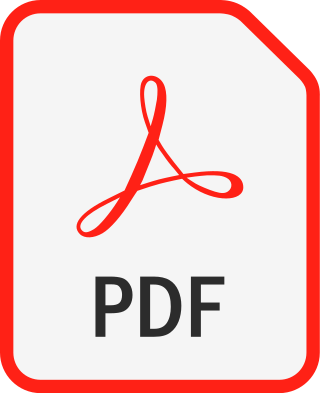
A markuplanguage is a text-encoding system which specifies the structure and formatting of a document and potentially the relationship between its parts. Markup can control the display of a document or enrich its content to facilitate automated processing.

Portable Document Format (PDF), standardized as ISO 32000, is a file format developed by Adobe in 1992 to present documents, including text formatting and images, in a manner independent of application software, hardware, and operating systems. Based on the PostScript language, each PDF file encapsulates a complete description of a fixed-layout flat document, including the text, fonts, vector graphics, raster images and other information needed to display it. PDF has its roots in "The Camelot Project" initiated by Adobe co-founder John Warnock in 1991. PDF was standardized as ISO 32000 in 2008. The last edition as ISO 32000-2:2020 was published in December 2020.

In computing, plain text is a loose term for data that represent only characters of readable material but not its graphical representation nor other objects. It may also include a limited number of "whitespace" characters that affect simple arrangement of text, such as spaces, line breaks, or tabulation characters. Plain text is different from formatted text, where style information is included; from structured text, where structural parts of the document such as paragraphs, sections, and the like are identified; and from binary files in which some portions must be interpreted as binary objects.
In computing, serialization is the process of translating a data structure or object state into a format that can be stored or transmitted and reconstructed later. When the resulting series of bits is reread according to the serialization format, it can be used to create a semantically identical clone of the original object. For many complex objects, such as those that make extensive use of references, this process is not straightforward. Serialization of object-oriented objects does not include any of their associated methods with which they were previously linked.

Extensible Markup Language (XML) is a markup language and file format for storing, transmitting, and reconstructing arbitrary data. It defines a set of rules for encoding documents in a format that is both human-readable and machine-readable. The World Wide Web Consortium's XML 1.0 Specification of 1998 and several other related specifications—all of them free open standards—define XML.
Abstract Syntax Notation One (ASN.1) is a standard interface description language (IDL) for defining data structures that can be serialized and deserialized in a cross-platform way. It is broadly used in telecommunications and computer networking, and especially in cryptography.
YAML(see § History and name) is a human-readable data serialization language. It is commonly used for configuration files and in applications where data are being stored or transmitted. YAML targets many of the same communications applications as Extensible Markup Language (XML) but has a minimal syntax that intentionally differs from Standard Generalized Markup Language (SGML). It uses Python-style indentation to indicate nesting and does not require quotes around most string values.
A document file format is a text or binary file format for storing documents on a storage media, especially for use by computers. There currently exist a multitude of incompatible document file formats.
Extensible Binary Meta Language (EBML) is a generalized file format for any kind of data, aiming to be a binary equivalent to XML. It provides a basic framework for storing data in XML-like tags. It was originally developed for the Matroska audio/video container format.
Various binary formats have been proposed as compact representations for XML. Using a binary XML format generally reduces the verbosity of XML documents thereby also reducing the cost of parsing, but hinders the use of ordinary text editors and third-party tools to view and edit the document. There are several competing formats, but none has yet emerged as a de facto standard, although the World Wide Web Consortium adopted EXI as a Recommendation on 10 March 2011.

JSON is an open standard file format and data interchange format that uses human-readable text to store and transmit data objects consisting of attribute–value pairs and arrays. It is a commonly used data format with diverse uses in electronic data interchange, including that of web applications with servers.
Fast Infoset is an international standard that specifies a binary encoding format for the XML Information Set as an alternative to the XML document format. It aims to provide more efficient serialization than the text-based XML format.
The Extensible Metadata Platform (XMP) is an ISO standard, originally created by Adobe Systems Inc., for the creation, processing and interchange of standardized and custom metadata for digital documents and data sets.
In the macOS, iOS, NeXTSTEP, and GNUstep programming frameworks, property list files are files that store serialized objects. Property list files use the filename extension .plist, and thus are often referred to as p-list files.
An image file format is a file format for a digital image. There are many formats that can be used, such as JPEG, PNG, and GIF. Most formats up until 2022 were for storing 2D images, not 3D ones. The data stored in an image file format may be compressed or uncompressed. If the data is compressed, it may be done so using lossy compression or lossless compression. For graphic design applications, vector formats are often used. Some image file formats support transparency.
This is a comparison of data serialization formats, various ways to convert complex objects to sequences of bits. It does not include markup languages used exclusively as document file formats.
The Office Open XML file formats are a set of file formats that can be used to represent electronic office documents. There are formats for word processing documents, spreadsheets and presentations as well as specific formats for material such as mathematical formulas, graphics, bibliographies etc.



